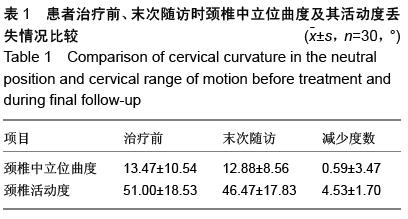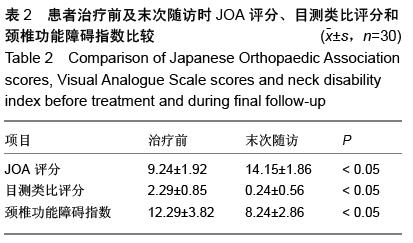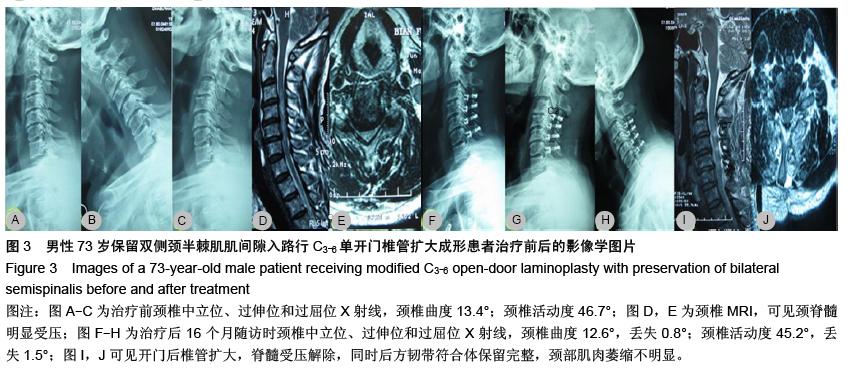| [1] 陈仲强,刘忠军,党耕町,等.脊柱外科学[M].北京:人民卫生出版社,2013: 242-243.[2] 李金虎.脊髓型颈椎病非手术诊治的研究进展[J].安徽医药,2012,16(8):1171-1173.[3] Fujimori T, Le H, Ziewacz JE, et al. Is there a difference in rang of motion, neck pain, and outcomes in patients with ossification of posterior longitudinal ligament versus those with cervical spondylosis, treated with plated lminoplasty? Neurosury Focus. 2013;35(1):E9.[4] 张春霖,曾照峰,唐恒涛,等.标本模拟微创颈椎管成形术椎管容积变化及临床意义[J].中国组织工程研究,2013,17 (26):4849-4856.[5] Chiba K, Ogawa Y, Ishii K, et al. Long-term results of expansive open-door laminoplasty for cervical myelapathy-average 14-year follow-up study. spine (Phila Pa 1976). 2006;31(26): 2998-3005.[6] Hirabayashi K. Expensive open-door laminoplasty for cervical spondylotic myelopathy(Jpn). Shujutsu. 1978; 32: 1159-1163.[7] 金正帅,张宁,吴庆,等.多节段颈椎间盘突出症的前后路手术疗效比较[J].中国修复重建外科杂志, 2004,18(6): 482-484. [8] 安春厚,刘学勇,原泉,等.颈椎管扩大成形椎间孔切开减压治疗颈神经根病[J].中国修复重建外科杂志, 2004,18(5): 396-398. [9] Kawaguchi Y, Kanamori M,Ishihara H, et al. Minimum 10-year follow-up after en bloc cervical laminoplasty. Clin Orthop Relat Res.2003;411:129-139. [10] Suda K,Abumi K, Ho M, et al. Local kyphosis reduces surgical outcomes of expansive open-door laminoplasty for cervical spondylotie myelopathy. Spine.2003;28(12):1558-1262.[11] Hirabayashi K,Miyakawa J,Satomi K,et al. Operative results and postoperative progression of ossification among patients with ossification of cervical posterior longitudinal ligament.Spine(Phila Pa 1976).1981;6(4): 354-364.[12] Huskisson EC. Measurement of pain. Lancet. 1974; 2(1889):1127-1131.[13] Vernon H. Mior S.The Neck Disability Index:a study of reliability and validity. J Manipulative Physiol The. 1991;14(7):409-415.[14] Zeng Y,Dang GD,Ma Q. Neck movement function evaluation after eervieal anterior fllsion. Zhonghua Wai Ke Za Zhi. 2004;42(24):1481-1484.[15] 夏跃冲,王卫东,刘宏建,等.颈椎动态稳定器植入术治疗单节段脊髓型颈椎病[J]. 中华实验外科杂志,2014,31(1): 192-194.[16] Sayana MK, Jamil H, Poynton A. Cervical laminoplasty for multilevel cervical myelopathy. Adv Orthop. 2011; 2011:241729.[17] 朱继超,刘晓光,刘忠军,等.术前颈椎曲度与椎管扩大成形术后脊髓后移程度及疗效相关性[J].中国脊柱脊髓杂志, 2013,23(7):587-593.[18] 李玉伟,王海蛟,严晓云,等.颈椎单开门椎管扩大成形术治疗多节段脊髓型颈椎病的疗效分析[J].中国脊柱脊髓杂志,2013,23 (11):973-978. [19] Kang SH, Rhim SC, Roh SW, et al. Postlaminoplasty cervical range of motion: early results. J Neurosurg Spine. 2007; 6(5): 386-390.[20] Kato M, Nakamura H, Konishi S, et al. Effect of preserving paraspinal muscles on postoperative axial pain in the selective cervical laminoplasty. Spine (Phila Pa 1976). 2008; 33(14): E445-449.[21] Sakaura H, Hosono N, Mukai Y, et al. Preservation of the nuchal ligament plays an important role in preventing unfavorable radiologic changes after laminoplasty. Spine Disord Tech. 2008; 21(5): 338-343.[22] Kawaguchi Y,Matsui H,Ishihara H, et al. Axial symptoms after en bloc cervical laminoplasty. J Spinal Disord. 1999;12(5):392-395. [23] Nolan JP, Sherk HH. Biomechanical evaluation of the extensor musculature of the cervical spine. Spine. 1988; 13(1):9-11.[24] 于森,孙宇,刘忠军.保留单侧肌肉韧带复合体颈椎椎板成形术近期疗效的比较研究[J].中国微创外科杂志, 2011, 1(11):76-81.[25] 王磊,王伟,张永兴.保留颈后方韧带复合体单开门椎管扩大成形术后其颈椎生理曲度及活动范围的中远期随访[J].中国脊柱脊髓杂志,2014,24(3):222-226.[26] 杨海云,顾锐,朱本清,等.影响单开门椎管扩大成形术治疗颈椎病疗效的术后相关因素分析[J].中华骨科杂志, 2009, 29(9):847-851.[27] 张大勇,任龙喜,王小平.颈椎单开门后方韧带复合体重建的临床观察[J]. 中国脊柱脊髓杂志,2006,16(2):118-120.[28] 林圣荣,周非非,孙宇,等.颈后路单开门椎管扩大成形术后颈椎矢状面平衡的变化[J].中华医学杂志, 2014,94(35): 2726-2730.[29] 张为,李鹏飞,申勇,等.颈后路三种手术方法对颈椎曲度及轴性症状的长期影响[J]. 中国矫形外科杂志, 2011, 17(19):709-712.[30] Masayuki U, Kunihko S, Taketoshi K, et al. A less-invasive cervical laminoplasty for spondylotic myelopathy that preserves the semispinalis cervicis muscles and nuchal ligament Clinical article. J Neurosurg Spine. 2013;18(6):545-552.[31] Hyun SJ,Riew KD,Rhim SC. Range of motion loss after cervical laminoplasty: a prospective study with minimum 5-year follow-up date.Spine. 2013;1(4): 384-390.[32] Shiraishi T,Kato M,Yato Y,et al. New Techniques for Exposure of Posterior Cervical Spine Through Intermuscular Planes and Their Surgical Application. Spine. 2012;37(5): E286-296. |





